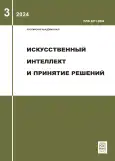Causes of Content Distortion: Analysis and Classification of Hallucinations in Large GPT Language Models
- Авторлар: Madzhumder M.S.1, Begunova D.D.1
-
Мекемелер:
- Moscow State Linguistic University
- Шығарылым: № 3 (2024)
- Беттер: 32-41
- Бөлім: Machine Learning, Neural Networks
- URL: https://journal-vniispk.ru/2071-8594/article/view/265357
- DOI: https://doi.org/10.14357/20718594240303
- EDN: https://elibrary.ru/KNHVPP
- ID: 265357
Дәйексөз келтіру
Толық мәтін
Аннотация
The article examines hallucinations produced by two versions of the GPT large language model – GPT-3.5-turbo and GPT-4. The primary aim of the study is to investigate the possible origins and classification of hallucinations as well as to develop strategies to address them. The work reveals the existing challenges that can lead to the generation of content that doesn't correspond to the factual data and misleads users. Detection and elimination of hallucinations play an important role in the development of artificial intelligence by improving natural language processing capabilities. The results of the study have practical relevance for developers and users of language models, due to the provided approaches that improve the quality and reliability of the generated content.
Негізгі сөздер
Авторлар туралы
Madina Madzhumder
Moscow State Linguistic University
Хат алмасуға жауапты Автор.
Email: mmadzhumder@gmail.com
Student, Department of Information and Analytical Activities
Ресей, MoscowDiana Begunova
Moscow State Linguistic University
Email: dbegunova01@gmail.com
Student, Department of Information and Analytical Activities
Ресей, MoscowӘдебиет тізімі
- Maynez J., Narayan Sh., Bohnet B., McDonald R. On Faithfulness and Factuality in Abstractive Summarization // arXiv e-prints. 2020. 14 с. URL: https://arxiv.org/pdf/2005.00661.pdf (accessed 06.07.2023).
- Introducing ChatGPT // OpenAI. URL: https:// openai.com/blog/chatgpt (accessed 06.07.2023).
- Vaswani A., Shazeer N., Parmar N., Uszkoreit J., Jones L., Gomez A., Kaiser L., Polosukhin L. Attention Is All You Need // arXiv e-prints. 2017. 15 с. URL: https://arxiv.org/pdf/1706.03762.pdf (accessed 06.07.2023).
- GPT-4 Technical Report / OpenAI // arXiv e-prints. 2023. 100 с. URL: https://arxiv.org/pdf/2303.08774.pdf (accessed 06.07.2023).
- Lightman H., Kosaraju V., Burda Y., Edwards H., Baker B., Lee T., Leike J., Schulman J., Sutskever I., Cobbe K. Let’s Verify Step by Step // arXiv e-prints. 2023. 29 с. URL: https://arxiv.org/pdf/2305.20050.pdf (accessed 06.07.2023).
- Peng K., Ding L., Zhong Q., Shen L., Liu X., Zhang M., Ouyang Yu., Tao D. Towards Making the Most of ChatGPT for Machine Translation // Cornell University. 2023. URL: https://arxiv.org/abs/2303.13780 (accessed 10.07.2023).
- Chen L., Zaharia M., Zou J. How Is ChatGPT’s Behavior Changing over Time? // arXiv eprints. 2023. 8 с. URL: https://arxiv.org/pdf/2307.09009.pdf (accessed 29.07.2023).
- All Systems Operational // OpenAI. URL: https://status.openai.com (accessed 06.07.2023).
- Brown T. B., Mann B., Ryder N., Subbiah M., Kaplan J., Dhariwal P., Neelakantan A., Shyam P., Sastry G., Askell A., Agarwal S., Herbert-Voss A., Krueger G., Henighan T., Child R., Ramesh A., Ziegler D.M., Wu J., Winter C., Hesse C., Chen M., Sigler E., Litwin M., Gray S., Chess B., Clark J., Berner C., McCandlish S., Radford A., Sutskever I., Amodei D. Language Models are Few-Shot Learners // arXiv eprints. 2020. URL: https://arxiv.org/pdf/2005.14165.pdf (accessed 06.07.2023).
- Razzhigaev A., Salnikov M., Malykh V., Braslavski P., Panchenko A. A System for Answering Simple Questions in Multiple Languages // Proceedings of the 61st Annual Meeting of the Association for Computational Linguistics. 2023. С. 524-537. URL: https://aclanthology.org/2023.acl-demo.51/ (accessed 29.07.2023).
- Models // OpenAI API. URL: https://platform.openai.com/docs/models/gpt-3-5 (accessed 06.07.2023).
- OpenAI Platform. URL: https://platform.openai.com/tokenizer (accessed 06.07.2023).
Қосымша файлдар








